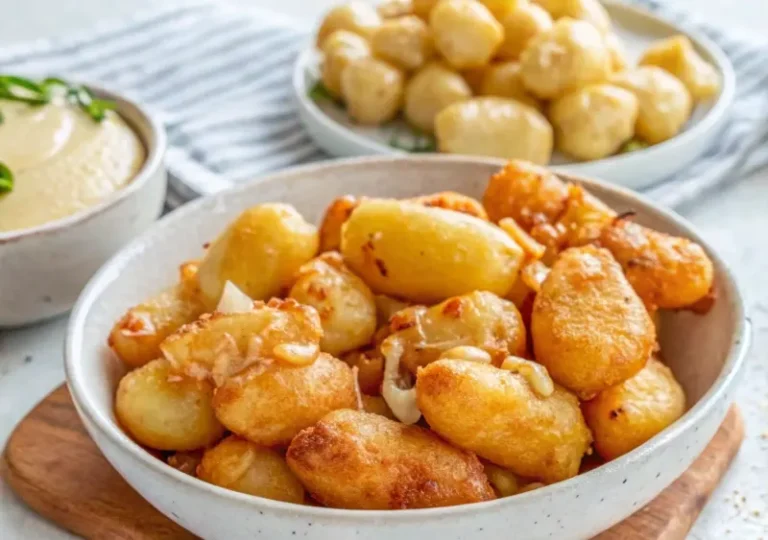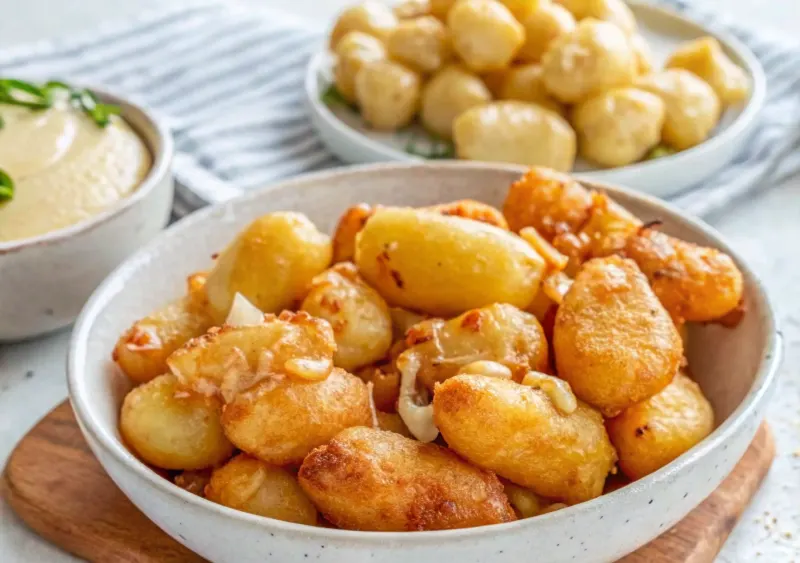Cheese curds are one of those quirky, delightful foods that make you do a double take. At first glance, they might not seem like much—just small, uneven chunks of cheese. But bite into one, and you’ll hear the famous squeak that brings so much joy to food lovers everywhere. Whether you’re dipping them in batter, tossing them into a bowl of poutine, or just snacking straight out of the bag, cheese curds are a crowd-pleaser with a surprising story. In this article, we’ll dive into the world of cheese curds, from their history and types to recipes and nutritional perks. Let’s dig in!
Table of Contents
What are Cheese Curds?
What Makes Cheese Curds Unique?
If you’ve ever bitten into a cheese curd, you know there’s nothing quite like that signature squeak. Cheese curds are essentially fresh chunks of cheese, separated from the whey during the cheese-making process. Unlike aged cheese, curds don’t go through the long aging process that gives other cheeses their distinct flavor. Instead, they’re served fresh, which is why they’re often called “squeaky cheese.”
That squeaky texture? It comes from the protein strands in the curd rubbing against your teeth—wild, right? Freshness is key, though; the squeakiness fades after a day or two, so you’ve gotta eat them fast! (Not that it’s ever been a problem for cheese lovers.)
The Science Behind Cheese Curd Formation
So, how does a humble gallon of milk transform into these delightful curds? It all starts with milk being heated and mixed with rennet (an enzyme). This causes the milk to curdle, separating into curds (the solid part) and whey (the liquid part). The curds are then cut into smaller pieces and stirred to help them firm up. After a bit of draining and salting, boom—you’ve got cheese curds!
Unlike their more refined cheese cousins, curds skip the molding, pressing, and aging stages. Think of them as the raw, unpolished gems of the cheese world. Fun fact: fresh cheese curds are considered best within just a few hours of being made, which is why they’re so popular in dairy-heavy regions like Wisconsin and Quebec.
The History and Origin of Cheese Curds
Tracing the Origins of Cheese Curds
You might think cheese curd is a modern snack invention, but nope—it’s been around for centuries! The origins of cheese curds go hand-in-hand with the history of cheese itself. Historians believe they were likely discovered by accident when early cheese-makers curdled milk using animal stomach enzymes. (Kind of gross, but hey, it worked!)
Regions with a strong dairy heritage, like Wisconsin and Quebec, embraced cheese curds early on. In Wisconsin, they’re practically a state treasure, and you’ll find them at fairs, roadside diners, and even gas stations. Meanwhile, Quebec is famous for turning cheese curds into poutine, a dish that’s become an international comfort food superstar. Over time, these humble curds have won fans far and wide, becoming a beloved snack and a staple in regional cuisines.
Cultural Importance and Popularity
Cheese curds have a unique way of bringing people together. In Wisconsin, locals celebrate them with festivals, like the annual Cheese Curd Festival in Ellsworth. And in Quebec, you can’t have a proper poutine without those squeaky curds. Globally, their popularity is on the rise as foodies discover the joy of frying, seasoning, and pairing cheese curds with everything from hot honey to craft beer. It’s fair to say that cheese curds have gone from a local delight to a worldwide obsession.
Types of Cheese Curds
Traditional Cheese Curds
Let’s talk about the OG cheese curd. Traditional cheese curds are made from fresh, unaged cheddar, and they’re prized for their mild, milky flavor and squeaky texture. Typically white or yellow, these curds are sold in irregular chunks because they’re broken off naturally during the curdling process.
You’ll often find them sold fresh in cheese shops or farmers’ markets, especially in dairy regions. If you’re lucky enough to snag them straight from a cheesemaker, you’ll notice the difference immediately. Fresh cheese curds don’t just taste better—they also squeak louder!
Flavored Cheese Curds
As cheese curds have grown in popularity, so have the creative ways people flavor them. Nowadays, you can find curds tossed in everything from garlic and dill to hot buffalo seasoning. Some curds are even coated in savory barbecue or tangy ranch powders.
For those with a sweet tooth, dessert-style curds are a thing too—hello, honey or cinnamon-sugar-coated curds! Flavored cheese curds are perfect for snacking and are a hit at parties and events. They also make great gifts (because, really, who wouldn’t love a bag of smoky-bacon-flavored cheese curds?).
Whether you’re a fan of the traditional or like to mix things up with funky flavors, there’s a cheese curd out there for everyone. And let’s not forget fried curds—they deserve their own category entirely (but more on that in the next part).
Cheese Curds in Cuisine
Famous Dishes Featuring Cheese Curds
One of the most iconic uses of cheese curd is in the beloved Canadian dish poutine. This mouthwatering combo of crispy fries, warm gravy, and squeaky cheese curds has become a global comfort food phenomenon. You can customize it with toppings like pulled pork, fried chicken, or even kimchi for a trendy twist!
In the United States, fried cheese curds reign supreme. Battered and deep-fried to golden perfection, these crispy snacks are a must-have at state fairs and local diners. Dip them in ranch or marinara sauce, and you’ve got yourself an irresistible treat.
Looking for more cheesy recipes? Check out Eminent Recipes’ guide to making creamy chicken tortellini soup for a hearty meal that pairs beautifully with cheese curds.
Pairing Cheese Curds with Beverages
Cheese curds aren’t just great for snacking—they also pair wonderfully with drinks! Try matching fried cheese curds with a light, crisp lager, or enjoy fresh curds with a fruity cider. Wine lovers, don’t worry—curds go great with sparkling wines or a smooth pinot noir. The saltiness of the curds balances the acidity and sweetness in your drink, making every bite and sip a delight.
Innovative Recipes Using Cheese Curds
Beyond poutine and fried curds, there are tons of creative ways to incorporate cheese curd into your cooking. Add them to a cheesy potato casserole, sprinkle them into a salad for a protein-packed crunch, or use them as a pizza topping. For breakfast lovers, mix cheese curds into scrambled eggs for an extra burst of creamy flavor. Feeling adventurous? Whip up mac and cheese with curds for an exciting texture twist!
Nutritional Information and Health Benefits
Nutritional Profile of Cheese Curds
Cheese curds aren’t just tasty—they’re pretty nutritious too! Packed with protein, calcium, and healthy fats, cheese curd is a great snack for growing kids and adults alike. A standard serving of cheese curds provides about 100 calories, 7 grams of protein, and plenty of bone-strengthening calcium. Plus, they’re gluten-free, making them suitable for people with dietary restrictions.
Health Benefits and Drawbacks
While cheese curds offer some great benefits, moderation is key. Their high protein content can keep you full and energized, but the sodium levels can be a little high, depending on how they’re prepared. If you’re frying them, keep in mind that battering and deep-frying adds extra calories and fats. That said, enjoying a few curds as part of a balanced diet is absolutely fine—everything in balance, right?
For more nutritious recipe ideas, visit Eminent Recipes’ collection of cottage cheese recipes for lighter options that complement cheese curds well.
Where to Find and How to Store Cheese Curds
Buying Fresh Cheese Curds
When it comes to cheese curd, freshness is the name of the game. The best place to find fresh cheese curds is at local dairy farms or cheese factories, especially in cheese-loving regions like Wisconsin or Quebec. Farmers’ markets often have curds made that very morning, ensuring you get the signature squeak in every bite.
If you’re not near a dairy hotspot, don’t worry. Many grocery stores now stock cheese curds in the deli section. You can also order them online from specialty retailers, but keep in mind that shipping time might affect their freshness. Pro tip: Look for curds labeled as “fresh” or “squeaky” to get the best quality.
Storage Tips to Maintain Freshness
Storing cheese curd properly is crucial to preserving their unique texture and flavor. Fresh cheese curds are best eaten within 24 to 48 hours of production, but if you can’t gobble them up right away, pop them in an airtight container and store them in the fridge.
Want to revive their squeak? Bring them to room temperature before eating, or toss them in the microwave for 5–10 seconds. While freezing cheese curds is possible, it can alter their texture, so it’s not ideal unless you’re planning to use them in cooked dishes like casseroles or poutine.
Cheese Curds Around the World
Regional Variations and Innovations
Although cheese curd is often associated with North America, variations can be found worldwide. In Quebec, they’re the cornerstone of poutine, while in Wisconsin, they’re fried to perfection and celebrated at fairs. Across the pond, you’ll find something similar in Scandinavian countries, where squeaky cheese, like Leipäjuusto in Finland, is enjoyed as a dessert with cloudberry jam.
Some regions even experiment with curd flavors, adding herbs, spices, or unique coatings. For instance, spicy jalapeño curds have become a hit in the U.S., and curry-flavored ones are gaining traction in parts of Europe. These innovations prove that cheese curds are far from ordinary.
Popular Festivals and Events Celebrating Cheese Curds
Cheese curd fans gather every year at festivals like the Ellsworth Cheese Curd Festival in Wisconsin, where attendees can sample curds in every possible form—fried, flavored, and even sweet. Similarly, Quebec hosts numerous poutine festivals that highlight the star ingredient: squeaky fresh curds.
If you can’t attend a festival, consider creating your own cheese curd celebration at home. Serve up fried curds with dipping sauces, or host a poutine bar with all the fixings. Cheese curds are always a party favorite!
FAQs:
What Makes Cheese Curds Squeak?
Ah, the famous squeak—it’s not just a gimmick, it’s science! The squeak comes from the elastic protein strands in fresh cheese curd rubbing against your teeth. This delightful sound is a sign of freshness and fades as the curds age or lose moisture. If you want to bring back the squeak, try warming them up slightly in the microwave.
Can Cheese Curds Be Frozen?
Yes, you can freeze cheese curds, but there’s a catch. Freezing affects their texture, often making them crumbly and less squeaky. While frozen curds are still fine for cooking (think casseroles, soups, or poutine), they’re not ideal for snacking. If you must freeze them, use an airtight bag and thaw them in the fridge before cooking.
Are Cheese Curds Gluten-Free?
Good news for gluten-sensitive folks: plain cheese curd is naturally gluten-free! However, if the curds are battered or flavored, check the labels to ensure there’s no hidden gluten in the seasoning or coating.
For more tips on using cheese in everyday cooking, check out Eminent Recipes’ guide to pimento cheese dips.
Conclusion:
Cheese curds may seem humble at first glance, but these squeaky bites hold a special place in the hearts (and stomachs!) of food lovers everywhere. From their origins in cheese-making traditions to their starring role in global cuisines, cheese curd proves that fresh simplicity can be absolutely delicious.
Whether you’re indulging in crispy fried curds, savoring a hearty bowl of poutine, or just popping a few fresh curds as a snack, there’s no denying their universal appeal. They’re fun, flavorful, and versatile enough to suit almost any taste.
So, the next time you see a bag of fresh cheese curds, don’t hesitate—grab them while they’re still squeaky. And if you’re feeling inspired, experiment with new recipes or pairings. After all, cheese curds are more than just a snack—they’re a culinary adventure waiting to happen.
For more delicious recipes and ideas, check out Eminent Recipes.
Facebook Eminent Recipes
Print
Cheese Curd
Cheese curds are squeaky, bite-sized pieces of fresh cheese that are a beloved snack in many regions. Whether enjoyed fresh or lightly fried for a crispy coating, they’re a versatile and delicious treat that pairs perfectly with your favorite dipping sauces or as a snack on their own.
Ingredients
- 1 pound fresh cheese curds
- 1 cup all-purpose flour
- 1 teaspoon baking powder
- 1 teaspoon garlic powder
- 1/2 teaspoon paprika
- 1/4 teaspoon salt
- 1 cup milk
- 1 large egg, beaten
- 1 cup breadcrumbs or panko (optional, for extra crunch)
Instructions
- Prepare Batter: In a mixing bowl, whisk together flour, baking powder, garlic powder, paprika, and salt. In another bowl, combine milk and egg.
- Dip Curds: Dip each cheese curd into the flour mixture, then into the milk mixture, and back into the flour (or breadcrumbs for a crunchier texture).
- Heat Oil: Heat vegetable oil in a deep skillet or fryer to 375°F.
- Fry: Fry the cheese curds in batches for 1-2 minutes, or until golden brown and crispy. Do not overcrowd the pan.
- Drain and Serve: Remove with a slotted spoon and drain on paper towels. Serve immediately with ranch dressing, marinara sauce, or your favorite dip.
Notes
- Freshness: Cheese curds are best when enjoyed fresh and squeaky; they lose their squeakiness after a few days.
- Reheating Fried Curds: Reheat leftover fried curds in the oven or air fryer at 350°F for 5-7 minutes to retain crispiness.
- Variations: Experiment with adding spices like cayenne pepper or Italian seasoning to the batter for extra flavor.
- Storage: Store fresh cheese curds in the refrigerator for up to 3 days. Fried cheese curds are best enjoyed immediately but can be refrigerated for up to 2 days.

